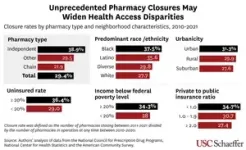(Press-News.org) Key study findings:
The rate of pharmacy store closures in recent years has more than doubled, affecting about 1 in 3 pharmacies between 2010 and 2021 and contributing to an unprecedented decline in the availability of pharmacies in the U.S
About one-third of counties experienced an overall decline in pharmacies, and the risk of closure was higher in predominantly Black and Latino neighborhoods.
Independent pharmacies, often excluded from networks by pharmacy benefit managers, were more than twice as likely to face closure compared to chain pharmacies.
Policymakers should consider several approaches for expanding pharmacy participation in preferred networks, particularly for Medicaid and Medicare Part D plans.
About 1 in 3 U.S. retail pharmacies have closed since 2010, with the vast majority of states experiencing an overall decline in drugstores in recent years, according to a new study from researchers at USC and the University of California, Berkeley. Pharmacy closures significantly impact public health, making it harder for people to access prescriptions and essential health services.
The study, published Dec. 3 in the journal Health Affairs, analyzes local and market characteristics of pharmacy closures between 2010 and 2021. With thousands of more pharmacy closures expected in the coming years, researchers said their findings offer a roadmap for identifying which communities are most at risk of losing drugstores and for crafting policies that may help them survive.
“At the same time many states are making efforts to expand the scope of pharmacy services beyond dispensing drugs to include the provision of preventive and emergency care, we found that there are—for the first time for at least a decade—fewer pharmacies available to provide them,” said senior author Dima Mazen Qato, a senior scholar at the USC Schaeffer Center for Health Policy & Economics and the Hygeia Centennial Chair and associate professor at the USC Mann School of Pharmacy and Pharmaceutical Sciences.
Accelerating closures have led to net loss in pharmacies for the first time since at least 2010
For most of the 2010s, pharmacy openings in the U.S. outpaced closures. And in previous work, the researchers found that pharmacies closed at a much slower rate during the first half of the decade, with 1 in 8 drugstores shuttered between 2009 and 2015.
Their new study finds an unprecedented decline in the number of pharmacies began in 2018, primarily driven by closures of chain pharmacies during an active period for industry consolidation. This included the merging of large pharmacy chains with dominant pharmacy benefit managers (PBMs), which negotiate prescription drug benefits and steer patients to preferred pharmacies.
Researchers identified pharmacies using a registry maintained by a national nonprofit and linked the data to county- and neighborhood-level data from the U.S. Census Bureau and the National Center for Health Statistics. Among their findings:
Between 2018 and 2021, the number of pharmacies declined in 41 states. During the entire study period (2010-2021), nearly one-third of counties experienced a net decline in pharmacies, affecting 91.6 million people.
In seven states, more than half of counties experienced a net decline in pharmacies: Illinois, Maine, Mississippi, New York, Pennsylvania, Rhode Island and Vermont.
At the community level, pharmacy closure rates were higher in predominately Black and Latino neighborhoods—37.5% and 35.6%, respectively—than predominately white ones (27.7%).
The last finding is partly explained by the struggles of independent pharmacies, which were more than twice as likely to close as chain stores. They were also much more likely to be in Black, Latino and low-income neighborhoods, as well as those with disproportionate rates of people with Medicare or Medicaid coverage.
“Our findings suggest that closures may widen health disparities in access to prescription and other essential pharmacy services, such as vaccinations and pharmacist-prescribed regimens, including contraceptives, medications for HIV prevention, and treatments for opioid use disorder," said first author Jenny Guadamuz, an Assistant Professor at the UC Berkeley School of Public Health and the Health Equity Program Director for the UC-Berkeley Center for Health Management & Policy Research.
"Without safeguarding pharmacies in marginalized neighborhoods, expanding health care services at pharmacies may enhance convenience for more affluent populations while failing to address the health needs of communities disproportionately affected by pharmacy closures, particularly Black and Brown populations in low-income urban areas," added Guadamuz.
Preventing Future Closures
“As highlighted in a recent FTC report, a key factor contributing to the higher risk of closure for independent pharmacies may be their frequent exclusion from preferred pharmacy networks,” said Guadamuz. PBMs use preferred pharmacy networks to encourage patients to visit certain locations by offering lower cost-sharing or out-of-pocket costs. The recent mergers of large pharmacy chains and PBMs also likely contributed to low reimbursements from PBMs at these combined companies to independent pharmacies and rival chain pharmacies, the researchers added.
The researchers said federal and state policymakers should consider policies that would increase participation of independent pharmacies in preferred networks. This could include mandating Medicare and Medicaid plans to give preferred status to pharmacies at heightened risk of closure or those serving “pharmacy deserts” with reduced access to pharmacy services.
In the commercial market, federal and state regulators should also consider requiring that PBMs’ preferred networks do not disproportionately favor pharmacy chains, including those part of the same company, the researchers said.
“Federal, state and local policies and programs should consider targeted strategies, including increases in Medicare Part D and Medicaid pharmacy reimbursement rates, to protect critical access pharmacies most at-risk for closure, particularly those serving neighborhoods that are or are at risk of becoming pharmacy deserts,” Qato said.
END
Nearly 1 in 3 retail pharmacies have closed since 2010
Recent chain store closures have driven an “unprecedented decline” in pharmacies, USC and UC Berkeley researchers find.
2024-12-03
ELSE PRESS RELEASES FROM THIS DATE:
‘Alaska’s Changing Environment’ — a new report
2024-12-03
The University of Alaska Fairbanks released a new report this week highlighting environmental changes and extremes that impact Alaskans and their livelihoods.
“Alaska’s Changing Environment” provides people with timely, reliable and understandable information on topics ranging from temperature and precipitation changes to salmon and polar bears.
The report was led by the Alaska Center for Climate Assessment and Policy at the UAF International Arctic Research Center, with contributions from more ...
nTIDE Deeper Dive November 2024: Employment trends highlight strength of veterans with disabilities
2024-12-03
East Hanover, NJ – December 3, 2024 – Veterans with disabilities continue to outperform the general population of people with disabilities in employment rates, highlighting the possible impact of specialized training and participation in essential industries, according to a new analysis shared during a National Trends in Disability Employment (nTIDE) Deeper Dive Lunch & Learn Webinar held on November 22. nTIDE is a joint effort by Kessler Foundation and the University of New Hampshire’s Institute on Disability (UNH-IOD).
Despite ...
Truck drivers need tailored health supports to Keep on Truckin’
2024-12-03
It might seem out of place on the side of a highway, but purpose-built exercise equipment installed at truck stops across Australia could be just the thing to encourage truck drivers to take a break and take control of their health and wellbeing.
In the first meta-analysis of how health behaviour interventions can affect truck drivers, researchers at the University of South Australia have found that tailored, multi-level and innovative approaches to truck driver health are required to enact positive change, as current interventions are not working.
Reviewing the effectiveness of health interventions for more than 2000 truck drivers across 19 studies, researchers found ...
Gluing treatment to cancer
2024-12-03
Treatment for more advanced and difficult-to-treat head and neck cancers can be improved with the addition of polyvinyl alcohol (PVA), the same ingredient used in children’s glue. Researchers found that combining PVA with a boron-containing compound, D-BPA, improved the effects of a type of radiation therapy for cancer, compared to currently clinically used drugs. The PVA made the drug more selective of tumor cells and prolonged drug retention, helping to spare healthy cells from unnecessary radiation damage.
Japan became the first country to approve boron neutron capture therapy (BNCT), a type of targeted radiotherapy for cancer, in 2020. Doctors ...
Oana Cojocaru-Mirédin of the University of Freiburg receives ERC Consolidator Grant
2024-12-03
Materials scientist Prof Dr Oana Cojocaru-Mirédin of the University of Freiburg has been awarded a Consolidator Grant from the European Research Council (ERC). With this grant, the European Union (EU) is funding her research project on the properties of what are known as grain boundaries in crystalline materials, such as those used for solar cells. The grant is among the most prestigious funding programmes for scientists in the EU. It provides almost two million euros for a five-year period. This ...
Peat-bog fungi produce substances that kill tuberculosis-causing bacteria
2024-12-03
An analysis of fungi collected from peat bogs has identified several species that produce substances toxic to the bacterium that causes the human disease tuberculosis. The findings suggest that one promising direction for development of better treatments might be to target biological processes in the bacterium that help maintain levels of compounds known as thiols. Neha Malhotra of the National Institutes of Health, U.S., and colleagues present these findings December 3rd in the open-access journal PLOS Biology.
Every year, millions of people around the world fall ill from tuberculosis and more than 1 million ...
How the speed of viral spread can be estimated by the analysis of genomic sequences
2024-12-03
Evaluating the speed at which viruses spread and transmit across host populations is critical to mitigating disease outbreaks. A study published December 3rd in PLOS Biology by Simon Dellicour at the University of Brussels (ULB), Belgium, and colleagues evaluate the performance of statistics measuring how viruses move across space and time in infected populations.
Genomic sequencing allows epidemiologists to examine the evolutionary history of pathogenic outbreaks and track the spatial movement of an outbreak. However, the sampling intensity of genomic sequences can potentially impact the accuracy of dispersal insights gained through these evolutionary ...
Lieber Institute for Brain Development named winner of 2024-2025 Amazon Web Services IMAGINE Grant for nonprofits
2024-12-03
Baltimore, Maryland (Dec. 3, 2024) — The Lieber Institute for Brain Development has been selected as a winner of the 2024 Amazon Web Services (AWS) IMAGINE Grant, a public grant opportunity open to registered charities in the United Kingdom and Ireland and registered 501(c) nonprofit organizations in the United States who are using technology to solve the world’s most pressing challenges. The Lieber Institute, located on the Johns Hopkins medical campus in Baltimore, will use the grant to develop a new generative AI tool to find new, more effective treatments for mental illnesses including schizophrenia.
Now ...
Overlooked emissions in California’s Salton Sea air basin
2024-12-03
At least one-quarter of all nitrogen oxide (NOx) emissions in California’s Salton Sea air basin come from soil, according to a study from the University of California, Davis.
Using isotopic analysis, the study found that annual total soil emissions for the basin were about 11 tons per day on average, which is 10 times larger than the state’s current inventory for soil NOx emissions in the region. The work was published in the Nature journal Scientific Reports.
The study highlights the need to ...
Democracy fatigue: An intelligent system that combines direct and representative politics helps to counter this
2024-12-03
Democracy is in crisis. Many people are losing confidence in political parties and parliaments and their ability to solve pressing social problems in the long term. Recent studies by the University of Stuttgart indicate that addressing doubts about the democratic system does not necessarily require resorting to the election of an autocratic head of state. Rather, more direct political participation could revitalize and legitimize democracy - provided that innovative participatory formats are intelligently linked to the work of representative institutions.
“Many people consider representative politics to be tiring ...
LAST 30 PRESS RELEASES:
Norbert Holtkamp appointed director of Fermi National Accelerator Laboratory
New agentic AI platform accelerates advanced optics design
Biologists discover neurons use physical signals — not electricity — to stabilize communication
Researchers discover that a hormone can access the brain by hitchhiking
University of Oklahoma researcher awarded funding to pursue AI-powered material design
Exploring how the visual system recovers following injury
Support for parents with infants at pediatric check-ups leads to better reading and math skills in elementary school
Kids’ behavioral health is a growing share of family health costs
Day & night: Cancer disrupts the brain’s natural rhythm
COVID-19 vaccination significantly reduces risk to pregnant women and baby
The role of vaccination in maternal and perinatal outcomes associated with COVID-19 in pregnancy
Mayo Clinic smartwatch system helps parents shorten and defuse children's severe tantrums early
Behavioral health spending spikes to 40% of all children’s health expenditures, nearly doubling in a decade
Digital cognitive behavioral treatment for generalized anxiety disorder
Expenditures for pediatric behavioral health care over time and estimated family financial burden
Air conditioning in nursing homes and mortality during extreme heat
The Alps to lose a record number of glaciers in the next decade
What makes a good proton conductor?
New science reporting guide published for journalists in Bulgaria
New international study reveals major survival gaps among children with cancer
New science reporting guide published for journalists in Turkey
Scientists develop a smarter mRNA therapy that knows which cells to target
Neuroanatomy-informed brain–machine hybrid intelligence for robust acoustic target detection
Eight SwRI hydrogen projects funded by ENERGYWERX
The Lundquist Institute and its start-up company Vitalex Biosciences Announces Strategic Advancement of Second-Generation fungal Vaccine VXV-01 through Phase 1 Trials under $40 Million Competitive Con
Fine particles in pollution are associated with early signs of autoimmune disease
Review article | Towards a Global Ground-Based Earth Observatory (GGBEO): Leveraging existing systems and networks
Penn and UMich create world’s smallest programmable, autonomous robots
Cleveland researchers launch first major study to address ‘hidden performance killer’ in athletes
To connect across politics, try saying what you oppose
[Press-News.org] Nearly 1 in 3 retail pharmacies have closed since 2010Recent chain store closures have driven an “unprecedented decline” in pharmacies, USC and UC Berkeley researchers find.







